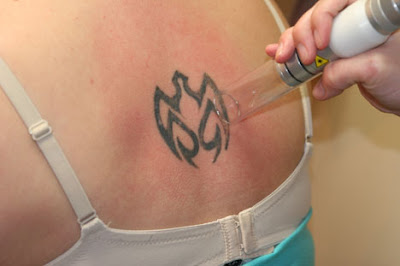 Laser tattoo removal can be quite painful. The pain is often described to be similar to that of hot oil on the skin, or a 'slap' from an elastic band; but when one considers the fact that a Q-switch laser can be fired around 10 pulses per second (by skilled laser-removal practitioners), the feeling of hot oil per pulse becomes moderately painful. So given the size and location of the tattoo, the process can be above the threshold of most people. Prescription strength topical anaesthetic creams or injections of anaesthetic solutions are usually used to manage pain, although some patients forgo any type of anaesthesia.
Laser tattoo removal can be quite painful. The pain is often described to be similar to that of hot oil on the skin, or a 'slap' from an elastic band; but when one considers the fact that a Q-switch laser can be fired around 10 pulses per second (by skilled laser-removal practitioners), the feeling of hot oil per pulse becomes moderately painful. So given the size and location of the tattoo, the process can be above the threshold of most people. Prescription strength topical anaesthetic creams or injections of anaesthetic solutions are usually used to manage pain, although some patients forgo any type of anaesthesia.Depending on the patient's pain threshold, and while some patients may forgo anesthesia altogether, most patients will require some form of local anesthesia. Pre-treatment might include the application of an anesthetic cream under occlusion for 45 to 90 minutes prior to the laser treatment session. If complete anesthesia is desired, it can be administered locally by injections of 1% to 2% lidocaine with epinephrine.
Anecdotal reports have noted that patients receiving anesthesia by local injection will require additional treatments as the injection causes mechanical edema, spreading out the tattoo ink, which in turn makes it more difficult for the laser light to act on specific ink particles. It has been reported that infiltration of local anesthesia will add an additional treatment or two.


No comments:
Post a Comment